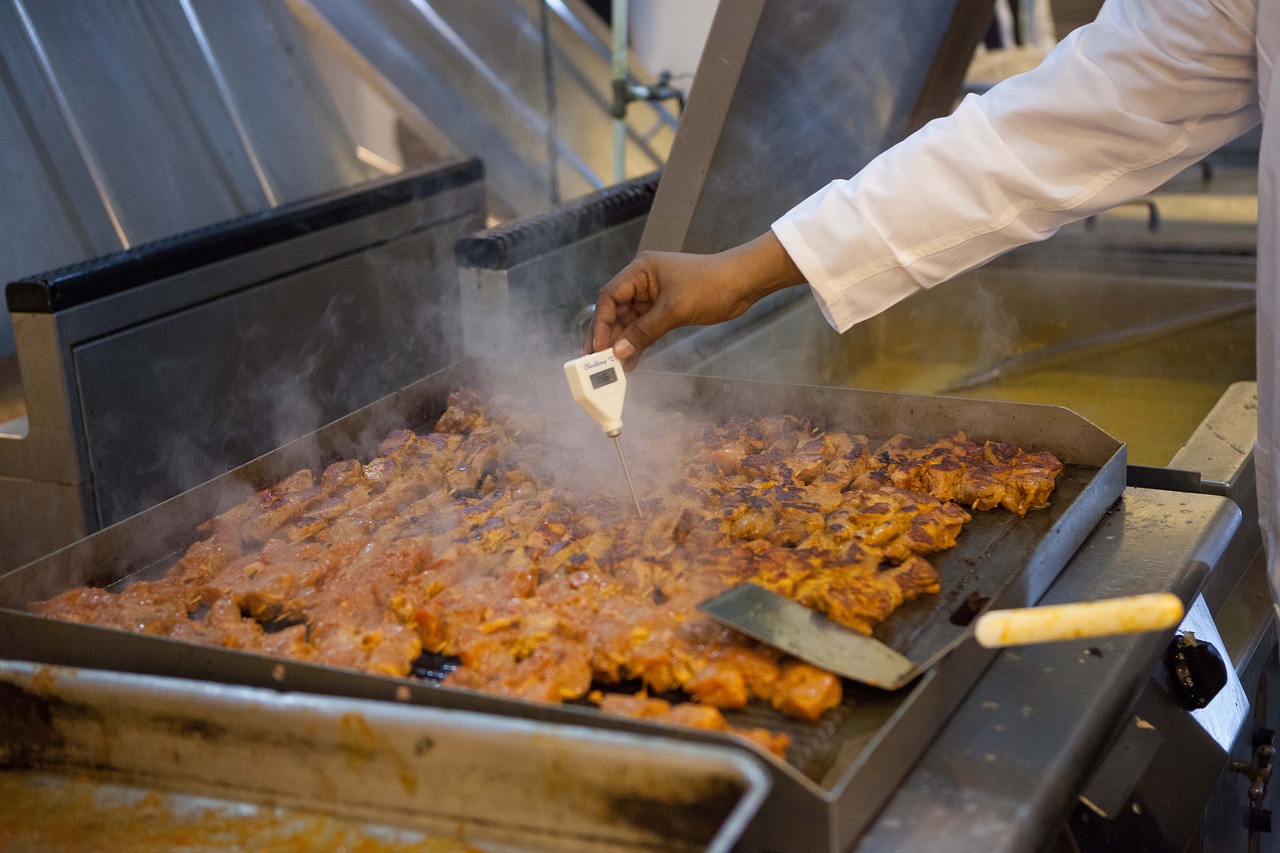In today’s fast-paced world, it can be challenging to prioritize our well-being while keeping up with our busy lives. But when it comes to our health, one aspect that should never be compromised is food safety. That’s why, here at Tastepan, we’ve dedicated ourselves to providing you with a collection of nutritious and delicious recipes. In this article, we’ll be taking a closer look at the best practices in the kitchen to ensure your meals are not only tasty but also safe for consumption. From proper storage techniques to handling raw ingredients, we’ll guide you through the essential steps to make healthy eating a breeze. So join us as we dive into Food Safety 101: Best Practices in the Kitchen!
Food Storage
Proper food storage is essential to keep your food fresh, prevent spoilage, and avoid foodborne illnesses. By organizing your refrigerator and freezer, understanding safe temperatures, and properly handling leftovers, you can ensure the quality and safety of your food.

Refrigerator Organization
Maintaining an organized refrigerator is not only visually appealing but also important for food safety. Start by keeping raw meats, poultry, and seafood on the bottom shelf to prevent any potential cross-contamination. Place cooked foods and ready-to-eat items on the upper shelves. Use clear storage containers to store leftovers and label them with the date to ensure you consume them in a timely manner. Always discard any food that has passed its expiration date or shows signs of spoilage.
Freezer Organization
In the freezer, it’s crucial to create a system that allows you to easily find and access your frozen items. Consider investing in storage bins or baskets to group similar items together. This will prevent you from having to dig through piles of frozen food and help minimize the time the freezer door remains open. It’s also a good practice to label your frozen items with their contents and date of freezing for better organization and to prioritize consumption of older items.
Safe Temperature
Maintaining a safe temperature in your refrigerator and freezer is key to preserving the quality and safety of your food. The optimal temperature for a refrigerator is below 40°F (4°C), while the freezer should be kept at 0°F (-18°C) or below. Use a refrigerator thermometer to regularly monitor the temperatures and make adjustments if needed. Avoid overstuffing your refrigerator or freezer, as it may hinder proper air circulation and compromise temperature regulation.
Properly Handling Leftovers
Leftovers are a convenient and delicious way to enjoy your meals again. However, it’s crucial to handle them properly to prevent foodborne illnesses. When storing leftovers, transfer them to shallow, airtight containers to promote rapid and even cooling. Refrigerate leftovers within two hours of cooking to prevent bacterial growth. When reheating leftovers, make sure they reach an internal temperature of at least 165°F (74°C) to kill any potential bacteria.
Food Handling
Proper food handling practices are essential to prevent the spread of bacteria and ensure safe consumption. By practicing good hand hygiene, preventing cross-contamination, ensuring safe food preparation, and cooking foods to the appropriate temperatures, you can minimize the risk of foodborne illnesses.
Hand Hygiene
Washing your hands thoroughly and frequently is one of the simplest yet most effective ways to prevent the spread of harmful bacteria and viruses. Always wash your hands with warm water and soap for at least 20 seconds before handling food, after using the bathroom, after touching raw meat or poultry, and after handling pets or any other potential sources of contamination.
Preventing Cross-Contamination
Cross-contamination occurs when harmful bacteria from one food item spread to other foods, surfaces, or utensils. To prevent cross-contamination, it’s important to keep raw meats, poultry, seafood, and their juices separate from other foods. Use separate cutting boards, knives, and utensils for raw and cooked foods. Clean and sanitize countertops, cutting boards, and utensils between use with different food items to ensure no cross-contamination occurs.
Safe Food Preparation
Proper food preparation is crucial to minimize the risk of foodborne illnesses. Thoroughly wash all fruits and vegetables under running water before consumption or cooking. Trim off any damaged or bruised areas and discard them. Keep perishable foods refrigerated until you’re ready to use them, and avoid leaving them at room temperature for an extended period. Additionally, ensure that all cooking surfaces, utensils, and equipment are clean and in good condition before starting food preparation.
Cooking Temperatures
Cooking food to the appropriate internal temperature is vital in killing harmful bacteria and ensuring its safety for consumption. Invest in a reliable food thermometer to accurately measure the internal temperature of various foods. Poultry, ground meats, and leftovers should reach a minimum internal temperature of 165°F (74°C), while steaks, roasts, fish, and eggs should reach a minimum internal temperature of 145°F (63°C). Cooking foods to their proper temperatures will help keep you and your loved ones safe from foodborne illnesses.
Cleaning and Sanitizing
Maintaining a clean and sanitary kitchen environment is essential to prevent the growth and spread of bacteria and other contaminants. Regularly cleaning surfaces and utensils, sanitizing them effectively, and properly washing your dishes are vital aspects of maintaining proper food safety.
Cleaning Surfaces and Utensils
Cleaning surfaces and utensils involves removing visible dirt and debris from them. Start by washing with warm, soapy water, using a clean sponge or cloth. Pay special attention to areas that come into contact with raw meats or potentially harmful substances. Rinse thoroughly with clean water and dry with a clean towel or let air dry. It’s important to wash cutting boards, countertops, knives, and other utensils after each use to prevent cross-contamination.
Sanitizing Surfaces and Utensils
Sanitizing surfaces and utensils goes beyond simple cleaning, as it involves using heat, chemicals, or other approved methods to kill any remaining bacteria, viruses, or other pathogens. After cleaning, you can sanitize surfaces and utensils by using a diluted bleach solution, following the manufacturer’s instructions. Alternatively, you can use sanitizing wipes or sprays specifically designed for kitchen use.
Dishwashing
Proper dishwashing is crucial in removing any residual food particles, grease, or bacteria that may be present on your dishes. It’s best to use hot, soapy water and a clean sponge or brush to scrub the dishes thoroughly. Pay attention to hard-to-reach areas, such as corners and crevices. Rinse the dishes with warm water to remove any soap residue. Allow them to air dry or use a clean towel to dry them completely before storage or reuse.
Personal Hygiene
Maintaining good personal hygiene habits is not only important for your overall health but also for preventing the contamination of food. By practicing proper hand washing techniques, using gloves when necessary, and avoiding food preparation when ill, you can ensure the safety of the food you handle.

Hand Washing
Hand washing is a simple and effective way to prevent the spread of harmful bacteria and viruses. Thoroughly wash your hands with warm water and soap for at least 20 seconds before and after handling food, after using the bathroom, after touching your face or hair, and after coughing or sneezing. This will help minimize the transfer of bacteria from your hands to the food you handle.
Gloves Usage
In certain situations, using gloves can provide an extra layer of protection to prevent cross-contamination. It is important to note that gloves should never replace proper hand washing. When using gloves, ensure they are clean and in good condition. Change gloves when moving from handling raw foods to ready-to-eat foods or when they become damaged or contaminated. Properly dispose of gloves after each use and wash your hands thoroughly.
Avoiding Illness
If you’re feeling unwell, it’s essential to avoid preparing food until you have fully recovered. Illnesses such as the common cold, flu, or gastrointestinal infections can easily be transmitted to food and can cause serious health issues if consumed by others. Rest, seek medical advice if necessary, and refrain from handling food until you have fully recovered to ensure the safety of everyone who consumes the food you prepare.
Kitchen Equipment
Using kitchen equipment properly and ensuring its safety and cleanliness is crucial for preventing accidents, maintaining food quality, and promoting overall kitchen efficiency.
Appliance Safety
When using kitchen appliances, it’s essential to follow the manufacturer’s instructions for safe operation. Ensure that appliances are in good working condition, free from any damage or malfunction. Keep cords away from hot surfaces, liquids, or sharp objects. Additionally, make sure to unplug appliances when not in use and clean them regularly according to the manufacturer’s recommendations.
Cutting Board Care
Proper care and maintenance of cutting boards are important for preventing cross-contamination and extending their lifespan. Use separate cutting boards for different types of food, such as one for raw meats and another for fruits and vegetables. Plastic cutting boards can be cleaned in the dishwasher, while wooden cutting boards should be washed with hot, soapy water and dried thoroughly. Regularly sanitize cutting boards with a diluted bleach solution or hydrogen peroxide to kill any remaining bacteria.
Knife Handling
Safe knife handling is crucial to prevent injuries and maintain efficient food preparation. Always use a sharp knife, as dull knives can slip and cause accidents. Hold the knife with a grip that feels comfortable and secure, with your fingers curled under and away from the blade. Pay attention to your cutting technique and always cut away from your body to avoid accidental cuts. Store knives in a designated knife block or drawer to prevent injury when reaching for them.
Proper Use of Utensils
Using utensils correctly not only promotes efficient food preparation but also ensures food safety. Avoid using damaged or broken utensils, as they can contaminate your food or cause accidents. Use separate utensils for raw and cooked foods to prevent cross-contamination. When stirring or tasting food, use clean utensils rather than reusing ones that have come into contact with raw ingredients. Regularly clean and sanitize your utensils to maintain their cleanliness and prevent the growth of bacteria.
Food Preparation
Proper food preparation techniques play a significant role in ensuring the safety and quality of the food you consume. By washing fruits and vegetables, thawing foods safely, marinating without risk, and handling eggs correctly, you can minimize the risk of foodborne illnesses.
Washing Fruits and Vegetables
Washing fruits and vegetables is an important step in removing any dirt, pesticides, or bacteria that may be present on their surfaces. Start by rinsing them thoroughly under running water. Use a clean brush or your hands to gently scrub the produce, especially for items with textured skin or leafy greens. Avoid using soap or detergent, as they can leave residues. Dry the produce with a clean towel or let them air dry before consumption or further preparation.
Thawing Foods
Properly thawing frozen foods is critical to maintain their quality and minimize the risk of bacterial growth. It’s best to thaw food in the refrigerator, as the cold temperature inhibits bacterial growth. Allow ample time for the food to thaw, as larger items may require several hours or even overnight. If you need to thaw food more quickly, you can use the microwave’s defrost function or submerge the tightly wrapped food in cold water, changing the water every 30 minutes until thawed.
Marinating Safely
Marinating is a popular technique to infuse flavors into meat, poultry, seafood, or vegetables. However, it’s important to marinate safely to prevent the growth of harmful bacteria. Always marinate in a food-grade container and refrigerate the marinated food. If you plan to use the marinade as a sauce or glaze, set aside a separate portion before adding the raw meat or poultry. Do not reuse marinades that have come into contact with raw meat or poultry unless cooked thoroughly to kill any bacteria they may contain.
Safe Egg Handling
Eggs are a versatile and nutritious ingredient, but they require proper handling to ensure their safety. Start by purchasing eggs from a reputable source and check for any signs of damage or cracks before purchasing. Store eggs in the refrigerator at or below 40°F (4°C). When using eggs, crack them into a separate container before adding them to your recipe to check for any abnormalities or signs of spoilage. Cook eggs thoroughly until both the yolk and white are firm to minimize the risk of salmonella contamination.
Pest Control
Preventing pest infestations in your kitchen is vital to maintain food safety and cleanliness. By practicing proper waste disposal, sealing food storage, and maintaining a clean kitchen environment, you can reduce the risk of pests and the contamination they bring.

Preventing Pest Infestations
Pests, such as rodents, insects, and cockroaches, can carry harmful bacteria and contaminate your food and surfaces. Preventing pest infestations starts with good sanitation practices. Regularly clean up food spills, crumbs, and debris. Keep your kitchen free of clutter and store food in tightly sealed containers. Seal any potential entry points, such as cracks or gaps in walls and floors.
Proper Waste Disposal
Proper waste disposal is crucial to prevent attracting pests and creating an unsanitary kitchen environment. Use sealed trash bins to contain any food waste. Empty your trash regularly, especially if it contains perishable or smelly items. Keep outdoor trash bins away from the entry points of your home or kitchen to avoid attracting pests indoors.
Sealing Food Storage
Properly sealing your food storage containers is essential to prevent pests from accessing your food. Use airtight containers or resealable bags to store dry goods, such as grains, cereals, and snacks. Check for any signs of damage or deterioration in your food storage containers and replace them if needed. Inspect your pantry regularly for any signs of pests, such as droppings or chew marks, and take immediate action to address the issue.
Maintaining a Clean Kitchen
Maintaining a clean and hygienic kitchen environment is an effective way to prevent pest infestations. Regularly clean and sanitize all surfaces, including countertops, tables, and floors. Pay attention to areas that may be easily overlooked, such as under appliances or in corners. Store your dishes, utensils, and other kitchen equipment in clean, dry areas. Wipe down spills and crumbs promptly to prevent pests from being attracted to your kitchen.
Allergen Management
Managing allergens in the kitchen is essential for the safety of individuals with food allergies. By identifying allergens, separating them, labeling appropriately, and avoiding cross-contact, you can create a safer environment for those with allergies.
Identifying Allergens
It’s vital to be knowledgeable about common food allergens to effectively manage them in the kitchen. The most common food allergens include peanuts, tree nuts, shellfish, fish, eggs, milk, soy, wheat, and sesame. Familiarize yourself with the ingredients in your recipes and keep a list of the allergens they contain. Always read food labels and be aware of potential cross-contamination risks.
Separating Allergens
To prevent cross-contact and minimize the risk of accidental exposure, it’s crucial to separate allergens from non-allergenic ingredients. Use separate cutting boards, utensils, and equipment for allergenic and non-allergenic foods. If possible, designate specific areas or times for preparing allergenic meals. Store allergenic ingredients in labeled containers away from non-allergenic items. By keeping allergens separate, you can help eliminate the risk of cross-contact.
Labeling Allergens
Properly labeling allergens on food containers, storage areas, and recipe cards is essential for clear identification and communication. Clearly mark any containers or packaging that contain allergens, both in the refrigerator and pantry. When preparing meals for others, provide clear and accurate labeling of the allergenic ingredients present in the dish. This will help individuals with allergies make informed decisions about what they can consume while avoiding potential risks.
Avoiding Cross-Contact
Cross-contact occurs when a food allergen comes into contact with a non-allergenic food, either directly or indirectly, resulting in potential allergen exposure. To avoid cross-contact, thoroughly clean and sanitize all utensils, cutting boards, and kitchen surfaces before and after preparing allergenic ingredients. Be cautious of shared cooking oils, grill grates, and cooking surfaces that may contain traces of allergens. Always check ingredient labels and consult with individuals with allergies to ensure their safety.
Foodborne Illnesses
Understanding common foodborne illnesses, their symptoms, and prevention methods is crucial for maintaining food safety. By being aware of the risks, practicing proper food hygiene, and seeking medical attention if needed, you can reduce the occurrence and impact of foodborne illnesses.
Common Foodborne Illnesses
Foodborne illnesses are caused by consuming contaminated food or beverages. Common types include salmonella, E. coli, norovirus, and listeria. These illnesses can cause symptoms such as nausea, vomiting, diarrhea, abdominal pain, fever, and dehydration. Different types of food are more prone to certain pathogens, so it’s important to be aware of the potential risks associated with various food items.
Symptoms and Prevention
Symptoms of foodborne illnesses can range from mild discomfort to severe complications, depending on the pathogen and individual’s health condition. The best way to prevent foodborne illnesses is through safe food handling practices, including proper hand washing, avoiding cross-contamination, cooking foods to appropriate temperatures, and practicing good personal hygiene. By understanding the symptoms and being vigilant in preventing contamination, you can significantly reduce the risk of foodborne illnesses.
Reporting Cases
If you suspect that you have contracted a foodborne illness, it’s important to report it to the appropriate authorities. Reporting cases of foodborne illnesses helps health departments identify potential outbreaks, investigate possible sources of contamination, and take necessary actions to prevent further cases. Contact your local health department or the appropriate regulatory agency to report your illness and provide any necessary information to aid the investigation.
Seeking Medical Attention
If you experience severe symptoms of a foodborne illness or if symptoms persist or worsen, it’s important to seek medical attention promptly. While most foodborne illnesses resolve on their own with proper rest and hydration, some individuals, such as young children, older adults, pregnant women, and those with weakened immune systems, may be at higher risk of complications. If in doubt, consult with a healthcare professional who can provide appropriate guidance and treatment.
Emergency Preparedness
Preparing for emergencies is crucial to ensure the safety of your food during unexpected events, such as natural disasters or power outages. By understanding how to safely store food, utilizing alternative cooking methods, ensuring water safety, and being aware of food safety practices during power outages, you can stay prepared and protect the well-being of yourself and your family.
Safe Food Storage during Emergencies
During emergencies, maintaining safe food storage is crucial, as power outages or interrupted water supply can compromise the safety of your food. It’s important to have an emergency preparedness kit that includes non-perishable food items, such as canned goods, dry goods, and other shelf-stable items. Store these supplies in a cool, dry place and rotate them regularly to ensure their freshness. Add ice packs or frozen water bottles to your refrigerator and freezer to keep them cold during power outages.
Alternative Cooking Methods
In the event of a power outage or limited access to conventional cooking methods, it’s important to have alternative cooking methods in place. Consider having a camping stove, outdoor grill, or a portable propane burner as backup options for cooking. Plan meals that require minimal cooking or utilize raw ingredients that can be safely consumed without cooking. Stock up on fuel sources, such as propane or charcoal, to ensure you have the necessary supplies during emergencies.
Water Safety
Water safety is essential during emergencies to prevent the risk of contamination and ensure hydration. Store an adequate supply of bottled water or consider investing in a water filtration system or water purification tablets. If tap water is unavailable, use bottled or filtered water for drinking and cooking. Follow local advisories and boil water if necessary to kill any potential pathogens. Be aware of how long stored water remains safe to drink and regularly rotate your emergency water supplies.
Food Safety for Power Outages
During a power outage, it’s crucial to take specific precautions to ensure the safety of your food. Keep refrigerator and freezer doors closed as much as possible to maintain the cold temperatures and prevent food spoilage. Use an appliance thermometer to monitor the temperatures inside, and if the refrigerator temperature rises above 40°F (4°C) for more than two hours, discard perishable items. If in doubt, remember the saying “When in doubt, throw it out” to avoid the risk of consuming potentially unsafe food.
By following these guidelines for food storage, handling, cleaning, personal hygiene, kitchen equipment usage, food preparation, pest control, allergen management, foodborne illnesses, and emergency preparedness, you can create a safer and healthier environment in your kitchen. Prioritize your well-being by implementing these best practices to ensure the freshness, quality, and safety of the food you consume. Happy cooking!

